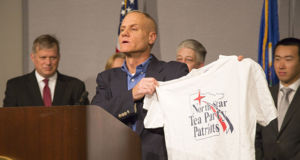Should Minnesota Restrict What We Wear to the Polls? The U.S. Supreme Court Will Decide.
February 28, 2017–Andy Cilek, Sue Jeffers and other Minnesotans are at the U.S. Supreme Court today to defend our right to wear, for lack of a better term, “political clothing” when we vote. Minnesota bans t-shirts or hats that suggest support for a world view, candidate or political party. It is a broad restriction on speech.
With the able assistance of our friends at the Pacific Legal Foundation, and the support of the ACLU, this case will finally be heard.

The case now before the justices began in 2010 when several groups sued after Minnesota officials made clear they wouldn’t permit residents to vote while wearing tea party apparel or buttons that said, “Please I.D. Me.” The buttons referred to legislation then under discussion in the state and ultimately defeated that would have required residents to show photo identification to vote.
Two voters who defied elections officials — one who wore a “Please I.D. Me” button and another who wore both a button and tea party T-shirt — were asked to cover up or remove the items. Both were ultimately allowed to vote wearing the apparel, though their names were taken down for potential prosecution. Andy Cilek, one of the voters confronted by poll workers, called the policy “absurd.”
Now, at the Supreme Court, Cilek’s side has both the support of the libertarian Cato Institute and the liberal American Civil Liberties Union, and his lawyer believes the case is not one that will divide the court along ideological lines.
Even though other states allow “political clothing” when Americans vote, with apparently few problems, Minnesota will defend its law.
Minnesota sees it differently. In court papers, it says the law is a “reasonable restriction” that preserves “order and decorum in the polling place” and prevents “voter confusion and intimidation.”
“I think what’s important to understand is the purpose of this prohibition is to protect the fundamental right to vote,” said Daniel Rogan, who is arguing the case for the state and said he doesn’t know of anyone being issued a fine of up to $300 allowed under the law. Lower courts have sided with the state.
Beyond Minnesota, state laws vary in their fashion policing of the polls.
Some states allow voters to wear whatever they want. Others bar campaign clothing directly related to candidates or issues on the ballot. Minnesota has a broad law that also bans “political” attire, including clothing promoting a group with understood political views, such as the tea party or MoveOn.org….
The Supreme Court last considered the issue of free speech at polling places in 1992 when the court upheld a Tennessee law prohibiting the display or distribution of campaign materials within 100 feet of a polling place.
Minnesota has that law; I can tell you as someone who volunteers as a lawyer and poll watcher each election, that it is a good one because it keeps the polling area free of the election-day campaign efforts and lets people vote in peace. It also recognizes the property rights of the building owner (often a church or public building but sometimes it is someone’s home in small towns) and keeps the voting zone neutral.
But restricting what citizens wear goes too far; everyone knows it is election day and that people are there to vote, to be political.
Here is the ACLU: “The American electorate is surely hardy enough to vote their conscience even if they notice their fellow citizens wearing, say, a Black Lives Matter or AFL-CIO T-shirt, a Women’s March hat, or a pro-life or peace-sign button,” the ACLU told the court in a brief.
You can read the entire article here: WASHINGTON (AP) — A “Make America Great Again” hat. A tea party T-shirt. A MoveOn.org button.